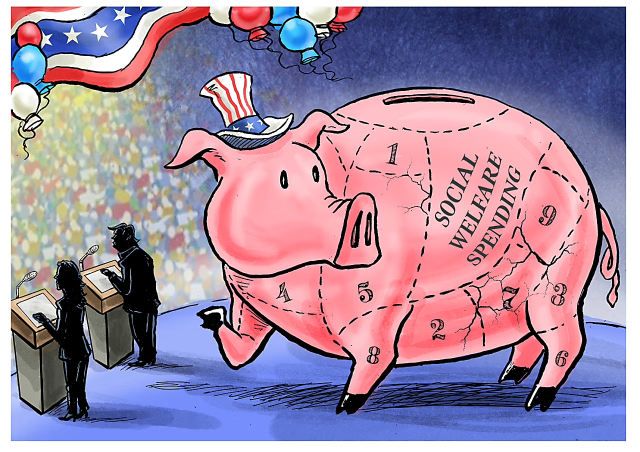|

ICYMI: WELFARE IS WHAT’S EATING THE BUDGET
Means-tested programs, not Medicare and Social Security, are behind today’s massive debt.

By Phil Gramm and Jodey Arrington
Sept. 11, 2024
AS SEEN IN THE WALL STREET JOURNAL

Ask any budget expert in Washington to explain the ballooning deficit and debt, and Social Security and Medicare will be high on the list of causes. That’s wrong. The real driver, the elephant in the room, is means-tested social-welfare spending—Medicaid, food stamps, refundable tax credits, Supplemental Security Income, Temporary Assistance for Needy Families, federal housing subsidies and almost 100 other programs whose eligibility is limited to those below an income threshold.
True, Social Security and Medicare are a drain on general revenue and will become big fiscal problems if not reformed. But they aren’t the major source of our current fiscal crisis, because both are financed in large part by dedicated payroll taxes. Since its inception, Social Security has produced cash surpluses 60% of the time. In 2023 Social Security payroll taxes funded 88.9% of benefits. The cost of Social Security’s Old-Age, Survivors and Disability Insurance program, net of payroll tax collections, was only $88.1 billion. Medicare payroll taxes and premiums funded 49.7% of Medicare expenditures, producing a net cost of $509 billion.
Means-tested social-welfare spending totaled $1.6 trillion in 2023. Welfare spending now absorbs an astonishing 72.6% of unobligated general revenue (total revenue net of Social Security and Medicare payroll taxes and premiums and mandatory interest on the public debt) and is larger than the claims against unobligated general revenue by Social Security (4.1%), Medicare (23.5%) and defense (37.2%) combined.
Since funding for the War on Poverty ramped up in 1967, welfare payments received by the average work-age household in the bottom quintile of income recipients has risen from $7,352 in inflation-adjusted 2022 dollars to $64,700 in 2022, the last year with available household income data. This 780% increase was 9.2 times the rise in income earned by the average American household.
Since 1967 defense spending has fallen from 68% of unobligated general revenue to 37.2% in 2023, almost a mirror image of the growth in means-tested welfare benefits. As defense spending plummeted, swords weren’t beaten into plowshares, which would have increased economic growth and wages, but were instead used to fund welfare payments. As a result, the U.S. today redistributes a larger share of its gross domestic product, 29.4%, through transfers and taxes than any developed country in the world except France with 30.1%.
After counting all transfer payments as income to the recipients and taxes as income lost by taxpayers, and adjusting for household size, the average households in the bottom, second and middle quintiles all have roughly the same incomes—despite dramatic differences in work effort. With the explosion of means-tested transfer payments, the portion of prime work-age persons in the bottom quintile who actually work has fallen to 36% from 68%. In the second quintile, households with a work-age adult who actually works have declined to 85% from 90%. While work effort fell in the bottom two quintiles, the percentage of middle-income households with a prime work-age person who works has risen to 92% from 86%.
The injustice of this government-created income equality is palpable. For about the same income, 2.4 times as many work-age persons in the second quintile actually work and on average work 85% more hours than those in the bottom quintile. And 2.5 times as many work-age middle-income persons actually work and work on average 108% more hours.
Americans overwhelmingly support an effective mandatory work requirement for able-bodied adults receiving welfare benefits. That’s evident in public opinion polls and ballot measures; in purple Wisconsin almost 80% of voters supported this in 2023. The bipartisan effort to reform Aid to Families with Dependent Children during the Clinton administration was a success.
Despite the subsequent granting of numerous waivers of work requirements, according to the Congressional Research Service, the 1996 Clinton welfare reforms reduced the rate of dependency of families on what is now called Temporary Assistance for Needy Families by 80%. Six years after the adoption of the reforms, the number of program beneficiaries had fallen dramatically, the labor-force participation rate of never-married mothers had increased, and child poverty had declined. State-imposed work requirements for food-stamp eligibility in Arkansas, Mississippi, Missouri and Florida have thus far also been successful.
Demand for reform would be even stronger if the public understood how generous social-welfare benefits are. In reporting household income, the Census Bureau doesn’t count 88% of transfer payments made to households that are defined as being poor. The census doesn’t count refundable tax credits (for which the beneficiary receives a check from the Treasury), food-stamp debit cards, free medical care through Medicaid, or benefits from about 100 other federal transfer payments as income to welfare recipients. When those benefits are counted as income, 80% of those who are today counted as being poor are no longer poor, and almost half have incomes equivalent to American middle-income earners.
A mandatory welfare work requirement for able-bodied adults receiving welfare benefits, a requirement that the Census Bureau count all transfer payments as income, and a mandate that all federal agencies use the same income measure when determining eligibility for welfare would be major steps toward righting the nation’s finances.
Requiring all able-bodied Americans to work as a condition for receiving welfare would do more than reduce the deficit. It would bring people back into the economy, the source of prosperity and economic independence. A job is the best nutrition, housing, healthcare, education, child-care and general welfare program. That welfare reform isn’t a major issue in the November elections is a missed opportunity to improve the well-being of low-income families and the overall economic health of the nation.
Mr. Gramm, a former chairman of the Senate Banking Committee, is a nonresident senior fellow at the American Enterprise Institute. Mr. Arrington, a Texas Republican, is chairman of the House Budget Committee. John Early and Mike Solon contributed to this article. |